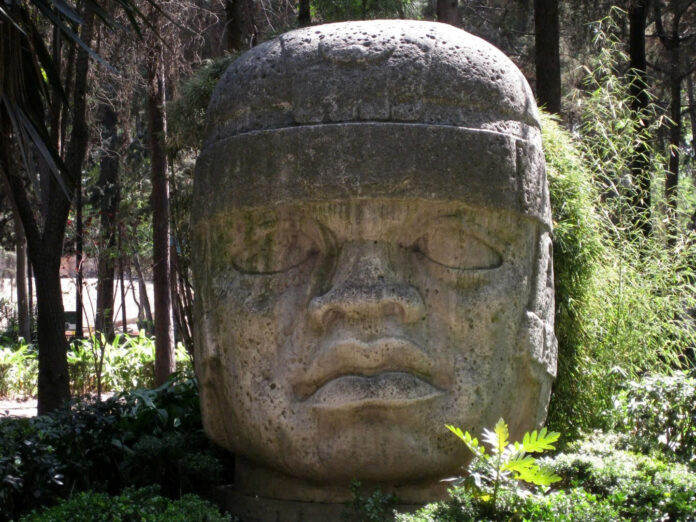Deep within Mexico’s humid Gulf Coast lowlands lie silent witnesses to one of humanity’s most enigmatic civilizations. These are the Colossal Olmec Heads—seventeen massive basalt sculptures that have captivated archaeologists and visitors alike for over a century. Standing as tall as 11 feet and weighing up to 50 tons each, these ancient stone giants represent far more than artistic achievement; they are windows into a lost world that flourished over 3,000 years ago.
The Discovery That Changed History
A Farmer’s Accidental Find
The story of these remarkable sculptures begins in 1862, not in a grand archaeological expedition, but in the mundane setting of a Mexican hacienda. A local farmer named José Melgar was working his field near Tres Zapotes when his plow struck something unusual buried beneath the earth. What emerged from the soil that day would reshape our understanding of ancient Mesoamerica—the first Colossal Olmec Head.
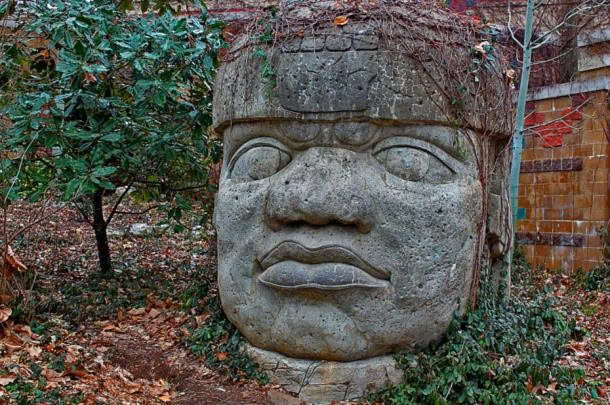
Locals had long known of the buried object, referring to it simply as a “pot,” never imagining they were living above one of archaeology’s greatest treasures. This chance discovery would spark decades of systematic exploration that would uncover sixteen more of these monumental sculptures across three major sites.
The Archaeological Awakening
The true significance of Melgar’s find didn’t become apparent until the 20th century. In 1945, archaeologist Matthew Stirling launched extensive excavations at San Lorenzo, uncovering ten additional heads through careful aerial surveys and methodical digging. His work was followed by Alfonso Caso’s investigations at La Venta, which yielded four more sculptures by 1958.
Each discovery added new pieces to the puzzle of Olmec civilization, revealing a society far more sophisticated than previously imagined. Carbon dating of surrounding materials placed these masterpieces between 1400 and 900 BC, establishing them as products of Mesoamerica’s earliest complex civilization.
Masters of Stone: The Olmec Civilization
A Society Built on Innovation
The Olmec people emerged around 1500 BC in the fertile river valleys of what is now Veracruz and Tabasco. Far from being simple farmers, they developed into Mesoamerica’s first urban civilization, earning the title “mother culture” for their foundational influence on later societies like the Maya and Aztecs.
Their settlements of San Lorenzo and La Venta were marvels of early urban planning. San Lorenzo, established by 1200 BC, featured complex systems of earthen mounds and drainage channels. La Venta, built later, boasted pyramid complexes that would inspire architectural traditions throughout Mesoamerica for centuries to come.
Economic Powerhouse of Ancient America
The Olmec economy was surprisingly sophisticated for its time. They cultivated the classic Mesoamerican trio of maize, beans, and squash in the rich floodplains, while also fishing the abundant rivers that crisscrossed their territory. But their influence extended far beyond agriculture.
Trade networks established by the Olmec stretched across vast distances, carrying precious jade and volcanic glass obsidian to markets as far south as Guatemala and as far north as central Mexico. These trade routes not only brought material wealth but also spread Olmec cultural influences throughout Mesoamerica, establishing artistic and religious traditions that would endure for millennia.
The Enigma of Individual Faces
Portraits in Stone
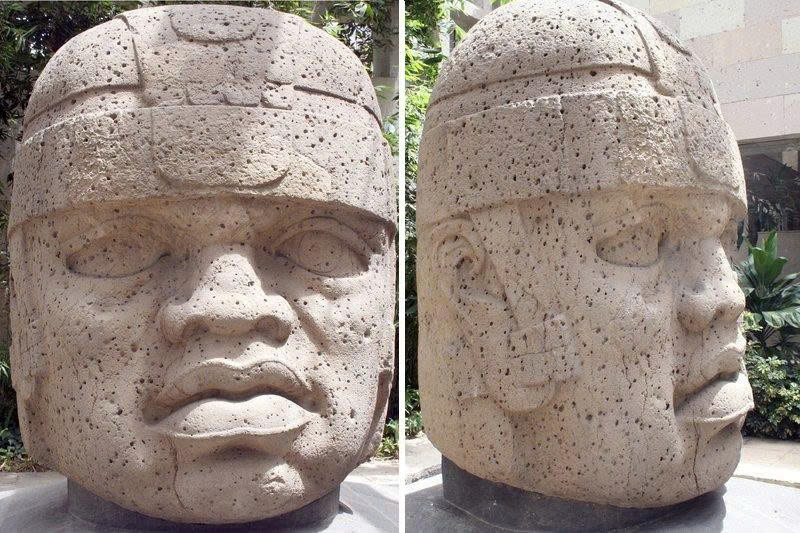
What makes the Colossal Olmec Heads truly extraordinary is their individuality. Despite sharing common characteristics—broad noses, full lips, and distinctive helmets—no two heads are identical. Each sculpture displays unique facial features, different helmet designs, and individual expressions that suggest these were portraits of specific individuals rather than generic representations.
San Lorenzo Head 1, standing 9.4 feet tall, wears an intricately patterned cap, while La Venta’s Monument 1, at 8 feet, features a plain helmet with distinctive ear flaps. Some heads display stern, authoritative expressions, while others seem more contemplative. This attention to individual detail was revolutionary for its time and speaks to the advanced artistic sophistication of Olmec sculptors.
The Question of Identity
The individuality of these sculptures raises fascinating questions about their purpose and the people they represent. Were these portraits of rulers, documenting a dynasty of Olmec kings? Could they be depictions of revered ancestors, honored in stone for eternity? Or might they represent deities or legendary heroes from Olmec mythology?
Without written records—the Olmec left no deciphered script—these questions remain tantalizingly unanswered. Each head stands as a silent guardian of secrets we may never fully unlock.
Engineering Marvels of the Ancient World
The Challenge of Creation
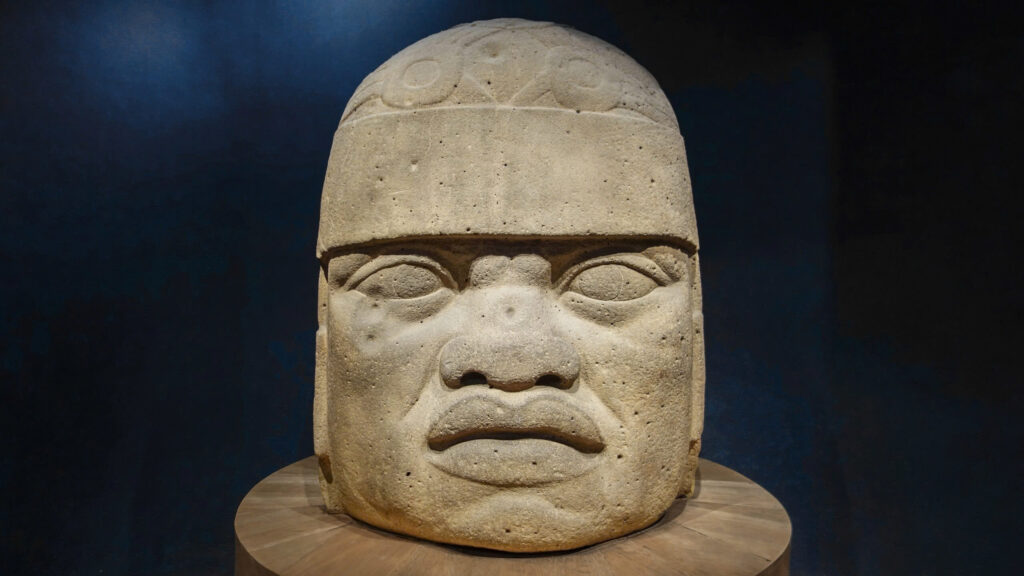
Creating the Colossal Olmec Heads required engineering skills and organizational capabilities that challenge our assumptions about ancient societies. The process began 50 to 60 miles away in the Tuxtla Mountains, where workers quarried massive basalt boulders from volcanic slopes near Cerro Cintepec.
Using only stone tools, fire, and wooden wedges, Olmec workers split enormous basalt formations, selecting boulders large enough to carve their monumental sculptures. The precision required for this selection process demonstrates a sophisticated understanding of stone properties and carving requirements.
The Great Transport
Moving 50-ton sculptures across 50 miles of challenging terrain represents one of ancient America’s greatest logistical achievements. The Olmec solution combined ingenuity with determination: massive basalt boulders were loaded onto wooden rafts and floated down rivers like the Coatzacoalcos during seasonal floods.
Once the rafts reached the vicinity of Olmec cities, the real challenge began. Teams of hundreds of workers, using a combination of log rollers, ramps, and human muscle power, transported these massive stones across swampy lowlands to their final destinations. The coordination required for such operations suggests a highly organized society with sophisticated management systems.
Artistry Without Metal
Perhaps most remarkably, the Olmec achieved their sculptural mastery without metal tools. Using flint chisels, stone hammers, and abrasive materials, skilled craftsmen spent months on each head, carefully removing stone to reveal the individual portraits hidden within the basalt.
The surfaces of these sculptures show a level of polish and detail that rivals later Mesoamerican works created with more advanced tools. Estimates suggest that each head required approximately 1,500 worker-days to complete—a massive investment of time and resources that speaks to their immense cultural importance.
Guardians Buried in Time
The Great Burial
One of the most intriguing aspects of the Colossal Olmec Heads is their deliberate burial around 900 BC. Rather than being abandoned or destroyed, these precious sculptures were carefully interred, as if their creators wanted to preserve them for future generations.
This systematic burial may have been part of religious ritual, political upheaval, or preparation for site abandonment. Whatever the reason, this act of preservation proved fortunate for modern archaeology, protecting the heads from centuries of weathering and human interference.
Preserved for Posterity
The humid, oxygen-poor environment of their burial sites created perfect conditions for preservation. When modern archaeologists finally uncovered these sculptures, they found them in remarkable condition, their carved details as sharp as the day they were completed over 3,000 years ago.
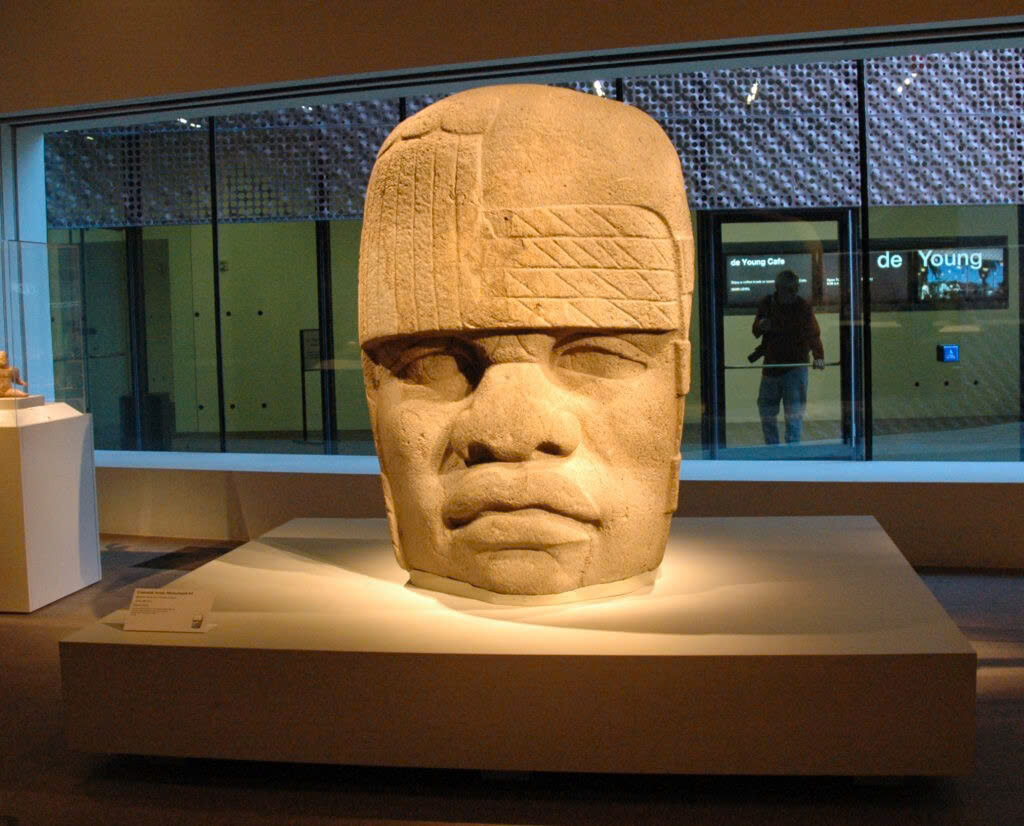
This preservation allows us to appreciate not only the artistic skill of Olmec sculptors but also their sophisticated understanding of human anatomy and individual character. The heads stand today as fresh and powerful as they did in ancient times.
Legacy of the Stone Giants
Modern Guardians
Today, most of the Colossal Olmec Heads reside in museums throughout Mexico, where they continue to inspire and educate new generations. The Museum of Anthropology in Veracruz houses seven of these masterpieces, while others are displayed in Mexico City and at archaeological sites.
However, preservation challenges continue. Some heads remain exposed to the elements at their original sites, facing threats from erosion, vandalism, and climate change. Conservation efforts use modern technology, including 3D scanning and digital mapping, to document these treasures and plan for their long-term protection.
Influence Across Time
The impact of Olmec civilization and their monumental art extended far beyond their own era. Later Mesoamerican cultures, including the Zapotec, Maya, and Aztec, drew inspiration from Olmec artistic traditions and urban planning concepts. The massive stone sculptures that would characterize Maya and Aztec art trace their origins back to these earliest colossal heads.
Even the great pyramid complexes of Teotihuacan and Chichen Itza owe a debt to the architectural innovations first developed at Olmec sites like La Venta. In this way, the Colossal Olmec Heads represent not just artistic achievement but the foundation stones of Mesoamerican civilization itself.
Eternal Questions in Stone
Mysteries That Endure
Despite more than a century of study, the Colossal Olmec Heads continue to guard their secrets. Without written records to guide interpretation, archaeologists must rely on artistic analysis, archaeological context, and cultural comparison to understand their significance.
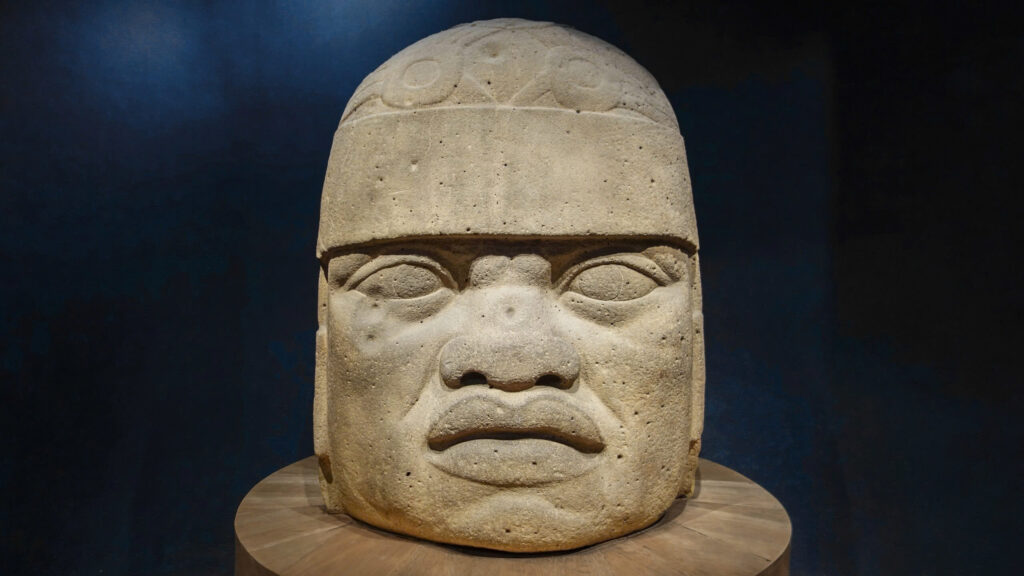
Why were these particular individuals chosen for immortalization in stone? What ceremonies or rituals accompanied their creation and eventual burial? How did Olmec society organize the massive labor forces required for their construction? These questions remain as compelling today as they were when the first head emerged from José Melgar’s field.
Video
Future Discoveries
The story of the Colossal Olmec Heads is far from over. Archaeological surveys suggest that more sculptures may remain buried in the swampy lowlands of the Gulf Coast. Each new discovery has the potential to add new chapters to our understanding of this remarkable civilization.
Advanced technologies like ground-penetrating radar and satellite imagery are revealing new archaeological sites throughout the former Olmec heartland. Who knows what other stone giants may be waiting beneath the earth, ready to share their ancient stories with the modern world?
Conclusion: Witnesses to Wonder
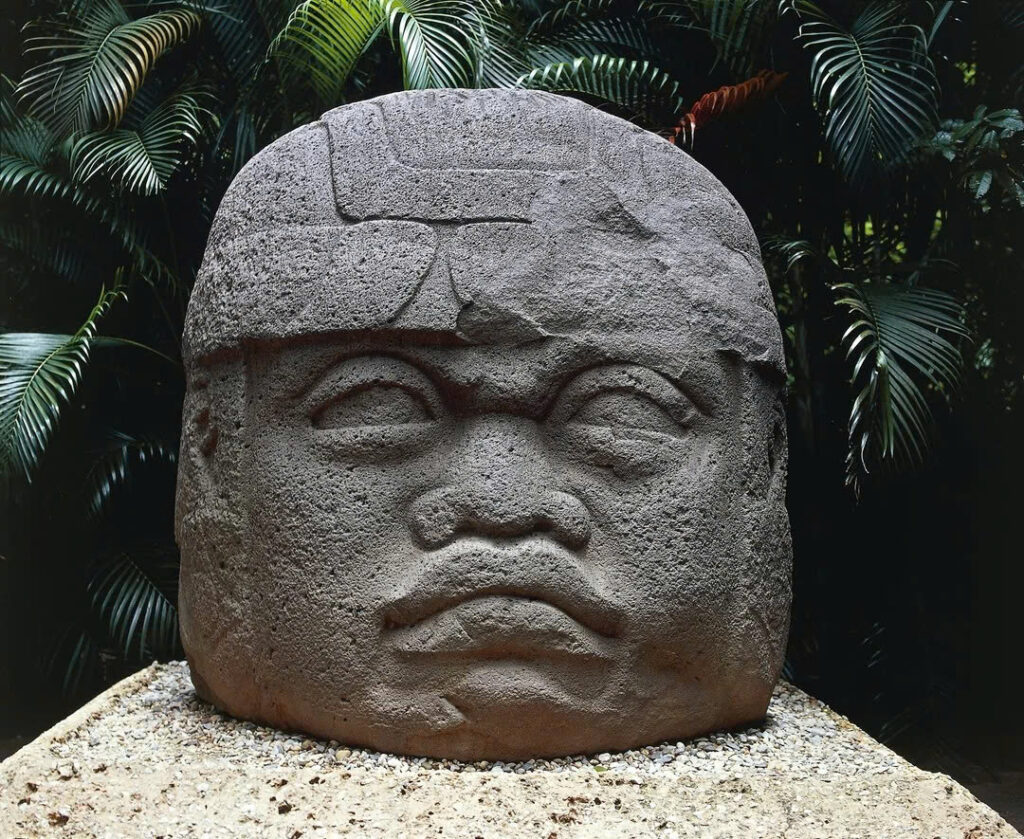
The Colossal Olmec Heads stand as humanity’s earliest monumental portraits, carved by master craftsmen who lived and worked over three millennia ago. They represent the intersection of artistic vision, technical skill, and social organization that would define Mesoamerican civilization for centuries to come.
More than mere sculptures, these stone giants are time machines that transport us back to a world where skilled artisans transformed volcanic rock into enduring works of art. They remind us that human creativity, ambition, and skill have remained constant throughout our species’ journey, even as the tools and techniques have evolved.
In their silent dignity, the Colossal Olmec Heads continue to inspire wonder and spark imagination. They stand as permanent testaments to the Olmec people’s remarkable achievements and enduring mysteries—stone guardians watching over secrets that may never be fully revealed, yet continue to enrich our understanding of human potential and ancient wisdom.
